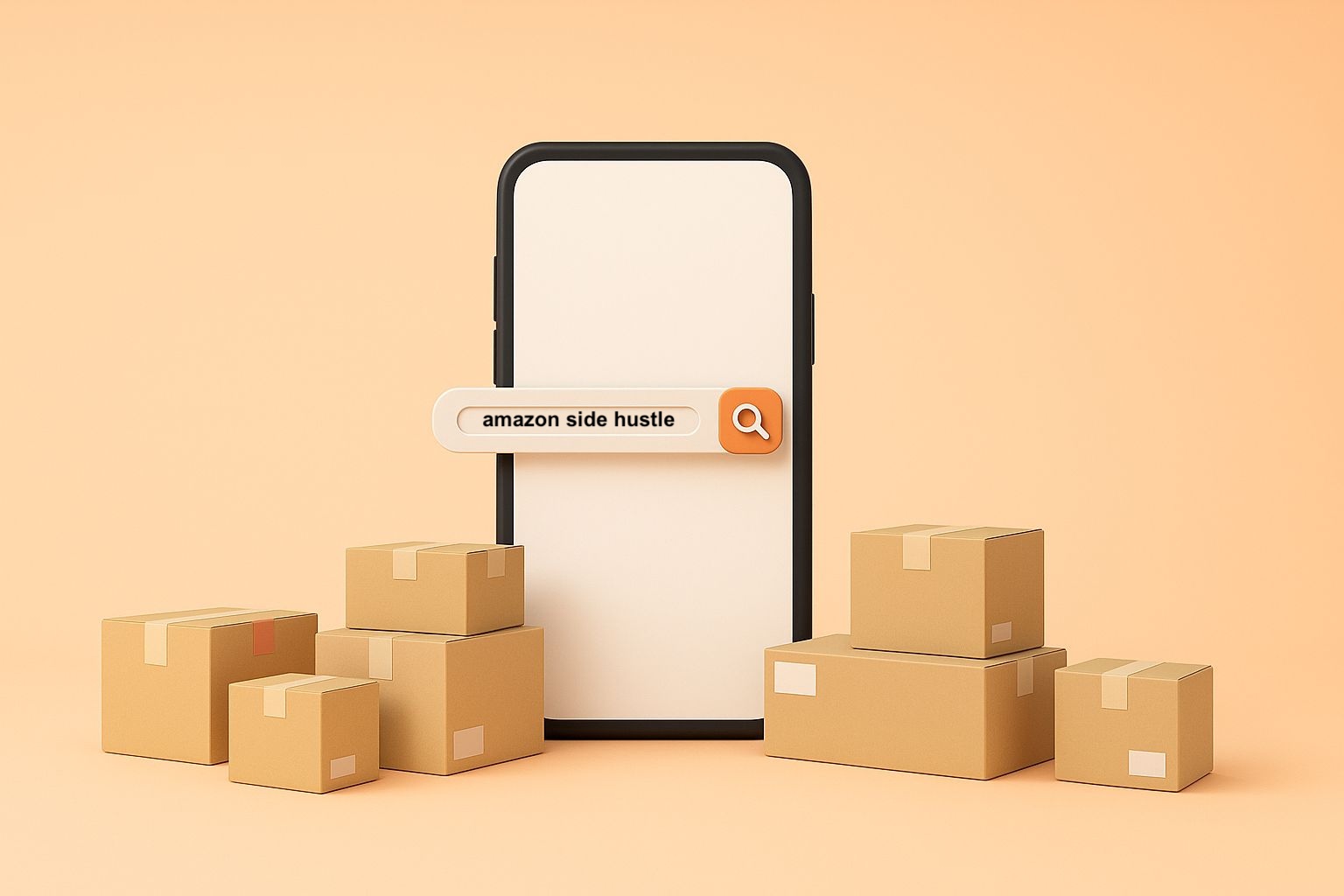Successfully Selling on Amazon: These 10 Commandments Every Seller Should Know!

Der Onlinehandel ist ein hartes Pflaster. Und der Erfolg mit Amazon FBA auf dem Marketplace ist besonders umkämpft. Wer seinen Verkaufsstand direkt am Eingang aufschlagen will, statt irgendwo in der letzten Ecke zu kampieren, muss Arbeit investieren. Es reicht nicht, seine Produkte irgendwie anzubieten und zu hoffen, dass genügend Käufer zufällig über das Angebot stolpern und es für gut befinden. Wer so vorgeht, wird weder auf Seite 1 der Suchergebnisse landen noch die Buy Box gewinnen – und damit so gut wie keine Chance haben, Umsatz zu generieren.
Stattdessen hat Amazon bestimmte Richtlinien, die über Gedeih und Verderb einzelner Artikel oder sogar eines ganzen Händlers entscheiden. Die gute Nachricht: Die entscheidenden Erfolgsfaktoren können Händler selbst regulieren und damit beeinflussen, wie sich ihr Umsatz bei Amazon entwickelt – positiv wie negativ. Ob man den Onlineshopper direkt abfangen kann oder ganz hinten ein einsames Dasein fristet, muss also niemand dem Zufall überlassen. Von Wundern kann aber auch keine Rede sein – Produkte erfolgreich auf Amazon zu verkaufen, funktioniert entgegen anderslautender Gerüchte nicht von heute auf morgen. Eine gute Optimierung braucht Zeit und lebt von ständiger Beobachtung und Anpassung. Worauf Händler dabei achten müssen, beleuchten wir in diesem Blogpost näher.
10 Gebote für Marktplatz-Verkäufer
1. Ranking-Optimierung oder Buy Box? Entscheide dich!
Ziel eines jeden Amazon-Händlers sollte es sein, entweder das Ranking eines Artikels zu optimieren oder die Buy Box zu gewinnen, um erfolgreich auf Amazon zu verkaufen. Beides zugleich ist nur in den seltensten Fällen sinnvoll. Stattdessen müssen sich Anbieter entscheiden und diese Wahl hängt maßgeblich von der Art des Produktes ab, wie die folgende Tabelle zeigt:
| OPTIMIERUNG DES RANKINGS | GEWINN DER BUY BOX |
|---|---|
| Eigenprodukte, die von sonst niemandem angeboten werdenHier hat der Händler die Hoheit über den Produkttitel und die -beschreibung, die Bilder sowie den sonstigen Content und kann diese entsprechend auf bestimmte Keywords hin optimieren. | Drittprodukte, die auch von anderen angeboten werdenBei Drittprodukten hat der Händler nur einen begrenzten Einfluss auf die Produktdarstellung, weshalb die Buy Box das Mittel der Wahl sein sollte, denn die meisten Käufer entscheiden sich für den Händler, den Amazon in der Buy Box präsentiert. |
2. Setzen Sie auf hochwertigen Content!
Schnell den Artikel mit dem Handy fotografieren – etwas schummrig, aber passt schon. Dann noch zwischen Tür und Angel die Produktbeschreibung hinschmieren – Rechtschreibfehler, na ja, macht ja jeder mal, oder nicht?
Stimmt vermutlich, trotzdem trägt Schludrigkeit nicht dazu bei, erfolgreich auf Amazon zu verkaufen. Die Produktbeschreibung, die Verkäuferinfos oder sonstiger Content, den der Kunde sieht, sollten immer so hochwertig wie möglich sein. Das wirkt seriös und schafft Vertrauen zum Händler. Das Produktdatenblatt sollte beispielsweise ausschließlich produktrelevante Inhalte bieten und die Ware ausführlich, aber dennoch konkret und – ganz wichtig – wahrheitsgemäß beschreiben. Ansonsten retournieren mehr Kunden, als eigentlich nötig wäre, selbst wenn es sich um hochwertige Ware handelt. Links zum eigenen Webshop oder Werbung für andere Ware gehören ebenfalls nicht in die Beschreibung.
Wenn es sich nicht gerade um einen schneeweißen Artikel handelt, ist ein heller Bildhintergrund immer noch die erste Wahl, denn damit kommt das Objekt selbst am besten zu Geltung. Eine ausreichend große Auflösung garantiert außerdem, dass der Kunde auch in der Vergrößerung noch Details erkennen kann.
3. Denken Sie an die SEO-Optimierung!
Sofern die Ranking-Optimierung das Mittel der Wahl ist, sollten Händler nicht die SEO-Optimierung aus dem Blick verlieren, die essenziell ist, um erfolgreich auf Amazon zu verkaufen. Welche Keywords für welches Produkt in der Beschreibung sinnvoll unterzubringen sind, müssen Händler erst herausfinden. Dazu bietet es sich beispielsweise an, über den Keyword Planner von Google Analytics oder andere kostenlose Tools wie keywordtool.io eine Recherche zum jeweiligen Artikel zu machen.

Eine andere gute Möglichkeit sind die Auto-Suggest-Angaben, die durch die Amazon-Suche vorgeschlagen werden. Bei “hundeleine” sind das zum Beispiel “flexi” oder “leder”. So können sich Händler einen guten Eindruck verschaffen, wonach potentielle Kunden überhaupt suchen. Auch Synonyme zu verbauen, ist eine gute Idee.
Keywords sollten zudem in den Bulletpoints enthalten sein. Eine Besonderheit des Marktplatz-SEO gegenüber der Google-Variante ist allerdings, dass die Keyword Density keine Bedeutung für den Erfolg auf Amazon hat. Bestimmte Wörter absichtlich mehrmals zu verwenden, ist daher nicht sinnvoll. Die wichtigsten sollten aber immer im Titel vorkommen. In den Bulletpoints bietet es sich dann an, weitere wichtige Keywords und Eigenschaften des Produkts unterzubringen, ohne wiederum die Lesbarkeit und Nützlichkeit des Inhalts oder die Zielgruppe aus den Augen zu verlieren.
4. Vermeiden Sie Keyword Dropping!
Trotzdem wäre es der falsche Weg, regelrechtes Keyword Dropping zu betreiben. Die Produktbeschreibung sollte immer gut leserlich und natürlich wirken und das Produkt so genau wie möglich beschreiben. Zu viele Keywords, vielleicht sogar ohne jeden Zusammenhang, vergraulen den Kunden eher, als dass sie dazu beitrügen, erfolgreich auf Amazon zu verkaufen. Da kann es schon hilfreicher sein, die verschiedenen Kundentypen beim Schreiben im Hinterkopf zu behalten.
Denn durch Unleserlichkeit, fehlende Informationen oder unnütze Beschreibungen würde die Verweildauer des Kunden erheblich sinken. Diese ist aber wichtig, um erfolgreich bei Amazon zu verkaufen, denn u. a. auf Basis der Verweildauer beurteilt der Algorithmus die Passgenauigkeit des Angebots zur Suchanfrage. Im schlimmsten Fall spielt der Algorithmus den Artikel zu dieser Suchanfrage gar nicht mehr aus und dem Händler entgehen Kaufabschlüsse, weil er beispielsweise bei der Produktbeschreibung oder dem Titel geschlampt hat.
5. Bieten Sie perfekten Kundenservice!
Was unterscheidet ein schlechtes Kundenerlebnis von einem guten? Mitunter nur der Kundenservice! Selbst wenn der Auftritt perfekt ist und das Produkt jede Auszeichnung gewinnt – schiefgehen kann immer etwas. Was zählt, ist die Erfahrung des Kunden, wie mit Problemen umgegangen wird. Ist diese positiv, kann selbst aus einem schlechten Erlebnis noch ein gutes werden. Kommt der Kunde danach sogar wieder, haben Händler definitiv erfolgreich auf Amazon verkaufen können.
Auf Anfragen von Kunden sollte zeitnah – das heißt möglichst noch heute – reagiert und alles getan werden, um das Anliegen zu lösen. Das ist manchmal einfach, weil es nur einer Auskunft bedarf (“Ist Ihre Hundeleine für kleine Hunde geeignet?”), manchmal aber auch schwierig (“Die Leine war schon kaputt! So ein Saftladen!”). Neben einer freundlichen und zuvorkommenden Antwort ist es nun wichtig, möglichst unkompliziert zu helfen, etwa mit einer schnellen Erstattung oder dem kostenlosen Versand eines Ersatzproduktes. Onlinehändler können sich dabei durchaus an den unbürokratischen Standards des Versandunternehmens orientieren, denn erfolgreiche Amazon-Händler haben verstanden, dass Käufer an die hohe Kundenorientierung des eCommerce-Giganten gewöhnt sind. Auch Geld-zurück-Garantien und Ähnliches schaffen Vertrauen. Das Stichwort ist hier definitiv Kulanz.
6. Pflegen Sie Ihre Bewertungen!
Schlechte Bewertungen von Produkten oder Händlern sind in der Onlinewelt niemals ein gutes Aushängeschild, und wenn man erfolgreich auf Amazon verkaufen will, erst recht nicht. Kunden wird der durchschnittliche Score ebenso angezeigt wie die einzelnen Bewertungen der Käufer, wodurch sie selbstverständlich den nächsten potentiellen Kunden in seiner Kaufentscheidung beeinflussen. Aber nicht nur das – auch der Amazon-Algorithmus registriert die Rezensionen und zieht bei zu vielen negativen Urteilen über einen Händler die Reißleine: Dann kommt der Gewinn einer Buy Box für diesen Händler nicht länger in Frage, was erhebliche Umsatzeinbußen zur Folge haben dürfte.
Daraus ergeben sich gleich mehrere Schlüsse:
Nur einwandfreie Artikel werden an den Kunden geschickt. Das ist ebenfalls ein wichtiger Punkt, denn die Retouren- und Mängelquoten haben wiederum Einfluss auf den Gewinn der Buy Box.
7. Bieten Sie einwandfreien Versand – oder FBA!
Nur wenige Faktoren beeinflussen die Kundenzufriedenheit so grundlegend wie die Versandbedingungen. Gerade für Marketplace-Händler ist es extrem wichtig, den hohen Standards des eCommerce-Riesen gerecht zu werden. Denn wer in der Amazon-Umgebung bestellt, hat auch eine entsprechende Erwartungshaltung. Dem Kunden Same-Day-Delivery, Wunschtermine oder eine Sendungsverfolgung anzubieten, kann daher den Unterschied ausmachen, ob Händler erfolgreich auf Amazon verkaufen können. Verspätete Lieferungen sind zudem ein No-Go – kommt das öfter vor, wirkt sich das unmittelbar auf Ranking und Buy Box aus.
Viele Händler nutzen daher Fulfillment by Amazon, kurz FBA. Damit übernimmt der Versandriese von der Lagerung bis zur Retoure das gesamte Fulfillment. Wer sich den Stress und den logistischen Aufwand sparen will, für den ist FBA eine der besten Möglichkeiten, auf erfolgreich auf dem Amazon-Marktplatz zu verkaufen. Denn damit sind die eigenen Waren automatisch in der Prime-Kategorie zu finden – und die hat mittlerweile einen erheblichen Einfluss auf die Kaufentscheidung von Onlineshoppern. Da der Service aber selbstverständlich nicht kostenlos ist, sollten Händler vorher genau überlegen, ob sich FBA für das gesamte Sortiment lohnt oder darüber auch nur die Top-Seller abgewickelt werden können.
8. Gestalten Sie Anzeigen mit Amazon PPC!
Als Amazon-Händler geht es immer darum, die eigene Sichtbarkeit in der Suche zu steigern und zu behaupten. Die SEO-Optimierung und die Buy Box spielen dabei eine entscheidende Rolle. Ergänzend gibt es jedoch auch die Möglichkeit, Werbeanzeigen in den Suchergebnissen zu platzieren. Bei „Pay per Click“ zahlen Händler pro Klick, der durch die jeweilige Anzeige generiert wird. Der Vorteil von Amazon PPC ist, dass mit diesem Tool in der Regel eine schnellere Verbesserung der Sichtbarkeit erzielt werden kann als mit einer reinen SEO-Optimierung.
Zugleich besteht jedoch auch eine Wechselbeziehung zwischen SEO und PPC. Während ersteres die Voraussetzung für eine gute Click-Trough-Rate der PPC-Kampagne ist, verbessert letztere wiederum das organische Ranking. Um erfolgreich auf Amazon zu verkaufen, sollten beide Maßnahmen also kombiniert werden.
9. Denken Sie auch an Marketing außerhalb von Amazon!

Amazon mag eine Welt für sich sein – Amazon-Nutzer tummeln sich aber überall. Der Versandriese vereint fast 70 Prozent Marktanteil am deutschen eCommerce in sich und hat damit eine beeindruckende Reichweite. Wer online shoppt, shoppt mit hoher Wahrscheinlichkeit auch auf Amazon. Potentielle Kunden warten also nicht nur in der Amazon-Suche auf Händler, sondern auch ganz generell in den Tiefen des World Wide Web.
Wer erfolgreich auf Amazon verkaufen will, sollte deshalb frühzeitiges Marketing betreiben und mit der eigenen Marke auch außerhalb von Amazon expandieren. Eine eigene Website, ein Newsletter und ein gut gepflegter Social Media-Auftritt sind dabei Gold wert. Auf diese Vertriebskanäle können findige Händler dann außerdem zurückgreifen, um positive Bewertungen zu generieren und die Einführung neuer Produkte voranzutreiben.
Dabei muss es nicht immer jeder Social Media-Kanal zugleich sein – lieber eine Plattform richtig bespielen, als alle Plattformen nur halbherzig zu pflegen. Entsprechende Tools wie Hootsuite helfen dabei. Denn je mehr Persönlichkeit und Emotionalität eine Marke bekommt, desto wahrscheinlicher ist eine gute Kundenbindung.
Zudem lässt sich durch Social Media, Google-Anzeigen und Verlinkungen auf der eigenen Website die Conversion-Rate steigern. Wer von dort mit Erfolg auf die Amazon-Angebote geleitet wird, kauft mit höherer Wahrscheinlichkeit dann auch bei diesem spezifischen Händler.
10. Behalten Sie Wettbewerber im Auge und passen Sie Ihre Preise an!
Den Markt und die Mitbewerber seiner Produktkategorie zu kennen und zu beobachten, ist für jeden Händler, der erfolgreich auf Amazon verkaufen will, ein Muss. Nichts ist ärgerlicher, als einen Trend zu übersehen, der eigentlich perfekt zur eigenen Marke gepasst hätte. Zudem ist der Preis einer der wichtigsten Faktoren, wenn es um Ranking, Buy Box und Verkaufsabschluss geht. Eine Preisabweichung von nur wenigen Prozentpunkten nach oben kann es bereits extrem unwahrscheinlich machen, dass sich ein Käufer für einen Artikel findet. Ein zu niedriger Preis ist aber ebenfalls nicht mehr unbedingt von Erfolg auf Amazon gekrönt, denn dem Konzern würden dadurch ebenfalls Einnahmen entgehen, weshalb der Algorithmus dies ebenfalls bestraft. Den Preis der anderen im Auge zu behalten, ist also entscheidend.

Die manuelle Preisanpassung mag bei einigen wenigen Artikeln im Portfolio noch zu meistern sein – bei größeren Sortimenten wird diese Aufgabe allerdings schnell ein Ding der Unmöglichkeit. Deswegen sollten Händler diesen Prozess automatisieren und entsprechende Repricer verwenden. Damit wird der Markt in jedem Moment analysiert und die Preise automatisch angepasst. Eine entsprechende Untergrenze garantiert zudem die wirtschaftliche Rentabilität.
Fazit: Erfolg auf Amazon ist mehr als nur SEO!
Das eigene Sortiment auf Amazon einzustellen, etwas SEO-Optimierung zu betreiben und dann auf regen Andrang zu hoffen – das funktioniert definitiv nicht! Als Onlinehändler erfolgreich auf Amazon zu verkaufen, ist Arbeit, denn der Versandriese fokussiert konsequent das Einkaufserlebnis des Nutzers und verlangt von seinen Marketplace-Händlern dieselbe Kundenorientierung, sei es beim Versand, dem Service oder Kulanzregelungen.
Mangelhafte Verkäuferleistung bestraft der Algorithmus schneller mit schlechten Rankings, als es den meisten Anbietern wohl lieb ist. Doch wer sich an die Spielregeln hält, die SEO-Optimierung auf Vordermann bringt und Marketing auch außerhalb des Amazon-Kosmos betreibt, kann von den Strukturen des Versandriesen profitieren und langfristig erfolgreich und profitabel sein.
Bildnachweise in der Reihenfolge der Bilder: © oatawa – stock.adobe.com / © tumsasedgars – stock.adobe.com / © Andrey Popov – stock.adobe.com







